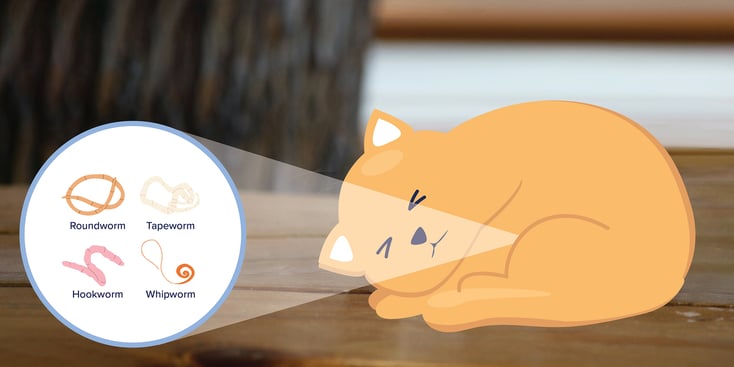Worms in Cats: Symptoms, Causes & Treatment

Table of Contents
Worms belong in the garden, not in our furry friends! If you have ever seen your cat pass a worm burden it can be an alarming sight. While easy to prevent, it’s often challenging to remember to give our cats the regular protection they need with the hectic pace of life. Worms can be easily prevented, illustrating the need for preventative health care for our cats.
Types of Worms in Cats
Cats can be infected with multiple types of worms, and each has the potential to cause damage in different ways. When cats are infected with more than one worm type, it can create an illness that affects more than one organ, such as the intestines, liver, lungs, and heart.
Types of worms that can infect cats are:
-
Tapeworm
-
Hookworm
-
Roundworm
-
Heartworm
-
Whipworm
-
Lungworm
-
Liver fluke
Not all of these worms will be present in your state, however. For example, the liver fluke requires subtropical temperatures and warmer states like Hawaii. If you are unsure what worms are prevalent in your area, ask a veterinarian what worms you need to know about.
When a cat gets a worm infection, the worms most commonly infect the intestinal lining, which can lead to long-term damage. Worms can spread from the intestines to other organs like the liver and create further damage. It’s often hard to detect a worm infection in your cat in the early stages, so often the signs are quite advanced before we notice them.
Signs & Symptoms of Worms in Cats
Worms can cause many symptoms. A kitten is more likely to suffer from a heavy worm burden than an adult, as their immunity is lower due to their age. Both adult cats and kittens can get worm burdens at any point in their life. The most common symptoms are:
-
Vomiting, with or without visible worms
-
Diarrhea or loose stools that may have visible worms
-
Diarrhea may contain small amounts of fresh pink/red blood or black dark granules that resemble coffee grounds
-
A poorly-conditioned coat
-
Changes in the membrane color from salmon pink to light pink, grey, yellow, or white.
-
Behavior changes: your cat may become a lot more hungry than normal or may become very lethargic and sleep most of the day.
Diagnosis of Worm Infections
If there is a heavy worm burden, you may be able to spot the worms in vomit or diarrhea. Small segments of worms that look like grains of rice may be noticeable around your cat’s bottom area.
A veterinarian can diagnose worms in cats by analyzing a fecal sample. The sample will reveal what kind of worms your cat has and the best treatment to use. A veterinarian may also want to run a blood test and do a health check-up at the same time to look for other secondary problems relating to worms such as anemia.
Treatment of Worms in Felines
The good news is, most worms in cats can be easily treated with standard deworming medications from your veterinarian. If your cat has a large infection, you may need repeated treatments within a short period of time and your vet will give you a dosing schedule for this. As dogs can become infected with worms from your cat, it’s important to treat all pets in your home simultaneously.
Tapeworms need fleas to complete their lifecycle, so if your cat has a tapeworm infection, you will need to treat your cat and your home for fleas as well as worms.
There is no licensed treatment for some worms, such as heartworm, which, unfortunately, means the infection can be fatal.
In some kittens or cats who have a very high worm burden, they may also have further problems such as anemia, or severe inflammation of the intestines, and may need a blood transfusion. This can be treated but may need a few days of hospitalized treatment to make a full recovery.
Prevention of Worms in Cats
Prevention of worms in cats is very easy with the many effective products that are on the market. When choosing a brand, make sure that the deworming product treats tapeworm as well as the other common worms, such as roundworm or whipworm. Tablets, oral liquids, and topical solutions are available. Talk to a veterinarian to decide which is the right option for you.
A kitten needs more frequent deworming than an adult cat. The recommended deworming schedule for a kitten is:
-
Every 2 weeks until 8 weeks old
-
Every 30 days thereafter
If you keep a litter box inside, you need to remove stools daily and disinfect the litter box weekly. It’s recommended to have more than one litter box per cat in your household.
Summary
Worm infestation in cats is a very common problem, but luckily, the symptoms are mild and easily treated. The best course of action is always prevention, so having a reminder logged into your calendar or phone is always a good idea. Some veterinary clinics can also send text or email reminders when your cat’s next treatment is due.
Frequently Asked Questions
What is the best treatment for Ringworm?
Ringworm may sound like a worm, but it’s actually a fungal infection that infects your cat’s skin. It’s treated with either topical or oral anti-fungal medications.
Can I get infected by worms from my cat?
Yes. Although it is rare for this to happen, you can contract worms from your cat. The age groups most likely to be affected are very young children or older r, or immune-compromised adults. Always wash your hands after cleaning the cat’s litterbox or touching stools. Learn more about the other contagious diseases you can contract from your cat.
Is a worm infection painful?
Yes, worms burrow into the intestinal layer causing inflammation and bleeding, which is painful to cats. A large worm burden can cause blockage of the intestines which would also cause pain.






